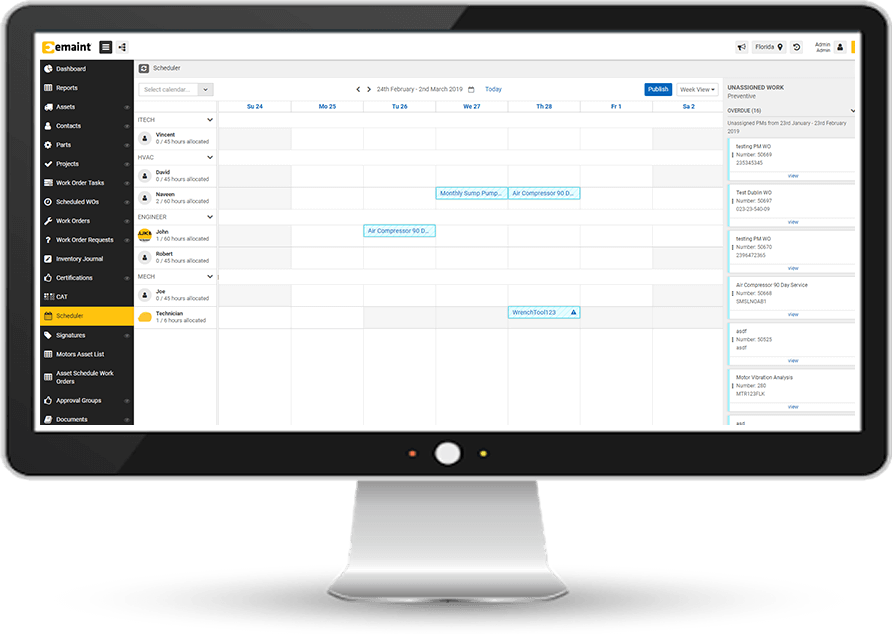What is Scheduled Maintenance?
Scheduled maintenance refers to planned repair and service tasks performed within a specified timeframe. This includes routine inspections, adjustments, and regular servicing, as well as planned shutdowns. Scheduled maintenance can be recurring, occurring at regular intervals, or triggered by specific work requests, ensuring efficient and timely upkeep of equipment and systems.
Factory scheduled maintenance – also known as time-based maintenance – is a good example of recurring scheduled maintenance. Just as most consumer vehicles require service at set mileage intervals to keep them running to the manufacturer’s specifications and keep warranties active, each piece of equipment will come with a recommended maintenance schedule from the manufacturer.
While forgoing factory scheduled maintenance may seem like an opportunity to reduce expenses, routine maintenance inspections and service can be essential to finding and resolving problems early. As a result, keeping assets up to date with factory-recommended maintenance may actually save costs in the long run. (Of course, condition-based maintenance can offer an even better approach — fixing assets when monitoring data shows it’s needed.)
Types of Scheduled Maintenance
Understanding the Different Types of Scheduled Maintenance
Scheduled maintenance is a crucial aspect of effective asset management, ensuring equipment reliability and operational efficiency. There are several types of scheduled maintenance, each serving a unique purpose in maintaining equipment health. Here are the primary types:
Time-Based Maintenance
-
- Definition: Maintenance activities are scheduled at regular, predefined intervals (e.g., weekly, monthly, quarterly).
- Example: Regular oil changes in machinery every three months to ensure optimal performance.
- Benefits: Prevents unexpected breakdowns and prolongs equipment lifespan
Usage-Based Maintenance
-
-
- Definition: Maintenance tasks are triggered based on usage metrics (e.g., operating hours, production cycles).
- Example: Replacing filters in an HVAC system after 1,000 hours of operation.
- Benefits: Aligns maintenance activities with actual equipment usage, reducing unnecessary maintenance.
-
Predictive Maintenance (PdM)
-
- Definition: Uses real-time data and advanced analytics to predict when maintenance should be performed.
- Example: Using vibration analysis on rotating equipment to detect early signs of wear and schedule maintenance before failure.
- Benefits: Minimizes downtime and maximizes asset availability by addressing issues before they escalate.
Condition-Based Maintenance (CBM)
-
- Definition: Maintenance is performed based on the actual condition of the equipment, often monitored through sensors and diagnostic tools.
- Example: Performing maintenance on a generator only when data indicates it’s operating outside of normal parameters.
- Benefits: Increases efficiency by focusing resources on equipment that truly needs attention.
Understanding these types of scheduled maintenance helps organizations implement a tailored maintenance strategy that optimizes equipment performance and reduces operational costs.
What are the Benefits of Scheduled Maintenance?
Scheduled maintenance ensures reliable asset performance and reduces unplanned downtime by keeping equipment in good repair and helping you identify issues early before they escalate the failure or shutdown. In addition, scheduled maintenance extends the lifespans of your assets and keeps your warranties active. These tasks can be performed in a strong maintenance scheduling software.
The Key Benefits of Scheduled Maintenance
Implementing a scheduled maintenance program offers numerous advantages that enhance the efficiency and longevity of equipment and systems. Here are the key benefits:
- Improved Equipment Reliability
- Benefit: Regular maintenance ensures that equipment operates at peak performance, reducing the likelihood of unexpected breakdowns.
- Example: Routine inspections and servicing of machinery prevent sudden failures that could disrupt production.
- Extended Asset Lifespan
- Benefit: By addressing wear and tear early, scheduled maintenance prolongs the life of equipment and reduces the need for premature replacements.
- Example: Regular lubrication and part replacements keep machines running smoothly, extending their usable life.
- Reduced Unplanned Downtime
- Benefit: Scheduled maintenance minimizes unexpected downtime by proactively addressing potential issues before they lead to failures.
- Example: A manufacturing plant that follows a strict maintenance schedule experiences fewer production halts due to equipment malfunctions.
- Cost Savings
- Benefit: Preventive maintenance can save money by avoiding costly emergency repairs and reducing the frequency of major overhauls.
- Example: Performing scheduled maintenance on HVAC systems prevents costly breakdowns and extends the time between major refurbishments.
- Enhanced Safety
- Benefit: Regular maintenance ensures that equipment operates safely, reducing the risk of accidents and injuries.
- Example: Regular checks of safety systems in industrial machinery ensure that all protective measures are functional, preventing workplace accidents.
- Compliance with Regulations
- Benefit: Scheduled maintenance helps organizations comply with industry regulations and standards, avoiding penalties and ensuring safe operations.
- Example: Adhering to maintenance schedules for medical device manufacturing assets ensures compliance with regulations and standards.
- Improved Efficiency
- Benefit: Well-maintained equipment operates more efficiently, reducing energy consumption and improving overall productivity.
- Example: Regular maintenance of production line machines ensures they run efficiently, reducing energy costs and increasing output.
- Better Resource Management
- Benefit: Scheduled maintenance allows for better planning and allocation of maintenance resources, optimizing labor and parts inventory.
- Example: Using CMMS software to plan maintenance tasks ensures that technicians and parts are available when needed, reducing downtime.
- Early Issue Detection
- Benefit: Routine inspections and servicing help identify potential issues early, before they escalate into major problems.
- Example: Regular checks of facilities equipment can identify leaks or weaknesses before they cause significant damage.
By integrating scheduled maintenance into your maintenance strategy, you can enjoy these benefits, ensuring your assets remain reliable, efficient, and safe. Leveraging a CMMS can streamline your scheduled maintenance processes, making it easier to reap these advantages.

What is the Difference Between Planned Maintenance and Scheduled Maintenance?
The terms planned and scheduled maintenance are often used interchangeably, but they have distinct differences, and each is a distinct preventive maintenance example. Both are needed for a comprehensive asset maintenance strategy:
Planned maintenance is the process of forecasting or anticipating asset maintenance requirements and strategically planning future maintenance. Planned maintenance is an overarching term that encompasses preventative maintenance, predictive maintenance, and condition-based maintenance strategies.
Scheduled maintenance is the process of determining who should complete maintenance tasks and when they should be completed. Rather than forecasting future maintenance needs, scheduled maintenance focuses on resolving issues that have already been identified, assigning a worker to the task as well as a deadline for task completion.
What is SMCP?
Scheduled maintenance critical percent (SMCP) is a metric used to prioritize maintenance tasks, especially when multiple tasks are overdue. SMCP calculates the number of days that a maintenance task is late relative to how frequently the maintenance task is scheduled to occur. The resulting number is expressed as a percentage. The higher the percentage, the higher that task should be on your list of maintenance priorities for maximum efficiency.
How is SMCP calculated?
To find the SMCP for each task, use the following formula.
(# of days late + # of days in the PM cycle) ÷ # of days in the PM cycle x 100 = SMCP
How to Use SMCP to Prioritize Maintenance Tasks?
What does SMCP look like in action? Let’s consider a system where several maintenance tasks are currently overdue. Task 1 is usually completed every 45 days and is now 4 days overdue. Meanwhile, another task is completed every 30 days and is now 3 days overdue. Task 3 is on a 90-day cycle and is 7 days overdue.
Which task should your maintenance team complete first? While at first glance, it may seem logical to tackle that most overdue task first, that may not be the optimal choice.
Let’s apply SMCP calculation to find out:
Task #1: (4+45) ÷ 45 x 100 = 109%
Task #2: (3+30) ÷ 30 x 100 = 110%
Task #3: (7+90) ÷ 30 x 100 = 108%
Based on SMCP, Task 2 has the highest percentage and should be prioritized ahead of Tasks 1 and 3, even though those tasks are more days overdue.
Conclusion
A comprehensive maintenance strategy ensures asset reliability and performance and keeps your operations running smoothly. Using CMMS software to incorporate scheduled maintenance into your maintenance strategy – along with other proactive measures like real-time condition monitoring and predictive maintenance – will help prevent shutdowns and unexpected maintenance costs. Meanwhile, leveraging SMCP enables you to effectively prioritize scheduled maintenance tasks and optimize your maintenance schedules.


